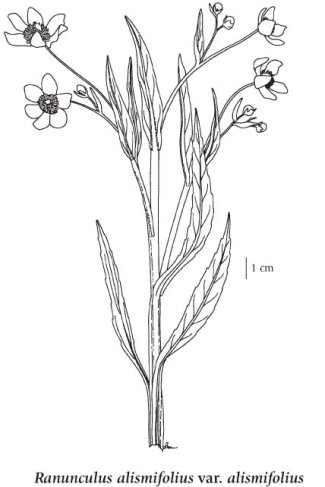Ranunculus alismifolius Geyer ex Benth. var. alismifolius
water-plantain buttercup (plantainleaf buttercup)
Ranunculaceae (Buttercup family)
Introduction to Vascular Plants
water-plantain buttercup (plantainleaf buttercup)
Ranunculaceae (Buttercup family)
Introduction to Vascular Plants
Map
Distribution of Ranunculus alismifolius var. alismifolius
Click here to view the full interactive map and legend
Species Information
General:
Perennial herb from fibrous or slightly tuberous roots; stems one to several, erect to ascending, branched in inflorescence, 15-60 cm tall, soft-hairy or smooth, somewhat hollow.
Leaves:
Basal and stem leaves lanceolate or narrowly egg-shaped, the blades 2-14 cm long, 0.7-3 cm wide, entire or slightly toothed, bases abruptly narrowed or rounded, tips pointed to blunt, the stalks stout, as long or longer than blades; stem leaves with shorter stalks, alternate; reduced to unstalked bracts above, sometimes opposite.
Flowers:
Inflorescence few- to several-flowered cymes; flower stalks lengthening in fruit, to 15 cm long; receptacle smooth; petals 5 (to 12), distinct, yellow, 5-14 mm long, 2-8 mm wide, nectary on upper surface, the nectary scale smooth, broadly egg-shaped; sepals 5, spreading or bent back from base, 2-6 mm long, 1-4 mm wide, somewhat hairy; stamens 25-90; pistils 10-60.
Fruits:
Achenes, 10 to 60 in an egg- to globe-shaped head 3-7 mm long, 4-8 mm wide, the achenes plump, 1.6-2.8 mm long, 1.2-2 mm wide, smooth or rarely stiff-hairy; beaks lanceolate to awl-shaped, straight or somewhat curved, 0.4-1.2 mm long.
Illustration

If more than one illustration is available for a species (e.g., separate illustrations were provided for two subspecies) then links to the separate images will be provided below. Note that individual subspecies or varietal illustrations are not always available.
Illustration Source: The Illustrated Flora of British Columbia
Habitat and Range
Wet ponds and shorelines to moist meadows in the lowland zone; rare in SW BC, known only from Victoria and Ballenas Island; S to ID, MT and CA.Status Information
| Origin Status | Provincial Status | BC List (Red Blue List) | COSEWIC |
|---|---|---|---|
| Native | S1 | Red | E (Apr 2009) |
BC Ministry of Environment: BC Species and Ecosystems Explorer.
Synonyms
Synonyms and Alternate Names:
Ranunculus alismifolius var. hartwegii (Greene) Jeps.
Ranunculus alismifolius var. lemmonii (A. Gray) L.D. Benson
Ranunculus alismifolius var. typicus L.D. Benson
Ranunculus hartwegii Greene
Ranunculus lemmonii A. Gray
Similar Species
Ranunculus alismifolius var. alismifolius is distinguished from most of the other Ranunculus species in B.C. by its simple, lanceolate leaves. R. flammula and R. glaberrimus also have lanceolate leaves, but the former is a much smaller, prostrate plant; the latter always has some deeply 3-lobed leaves. R. cymbalaria also has simple leaves, but they are cordate and deeply crenate-toothed to shallowly 3-lobed at the tips. R. alismifolius var. alismifolius is the tallest of the five varieties. It usually has toothed leaves; the other varieties always have entire leaves. The basal leaves of R. alismifolius var. alismifolius superficially resemble those of Plantago lanceolata. After flowering, the foliage of R. alismifolius var. alismifolius turns a distinctive and conspicuous yellow-green.
Source: British Columbia Conservation Data Centre |